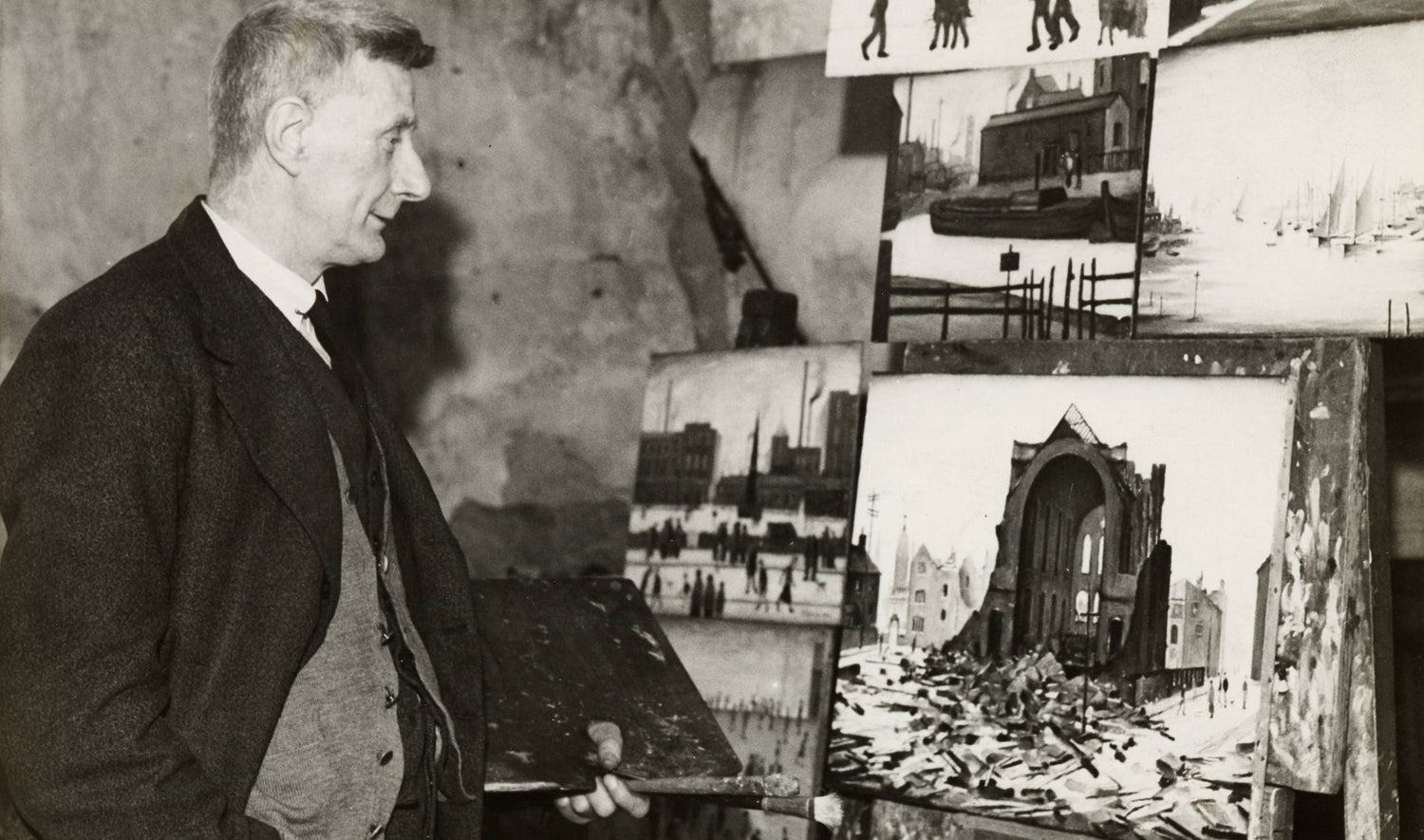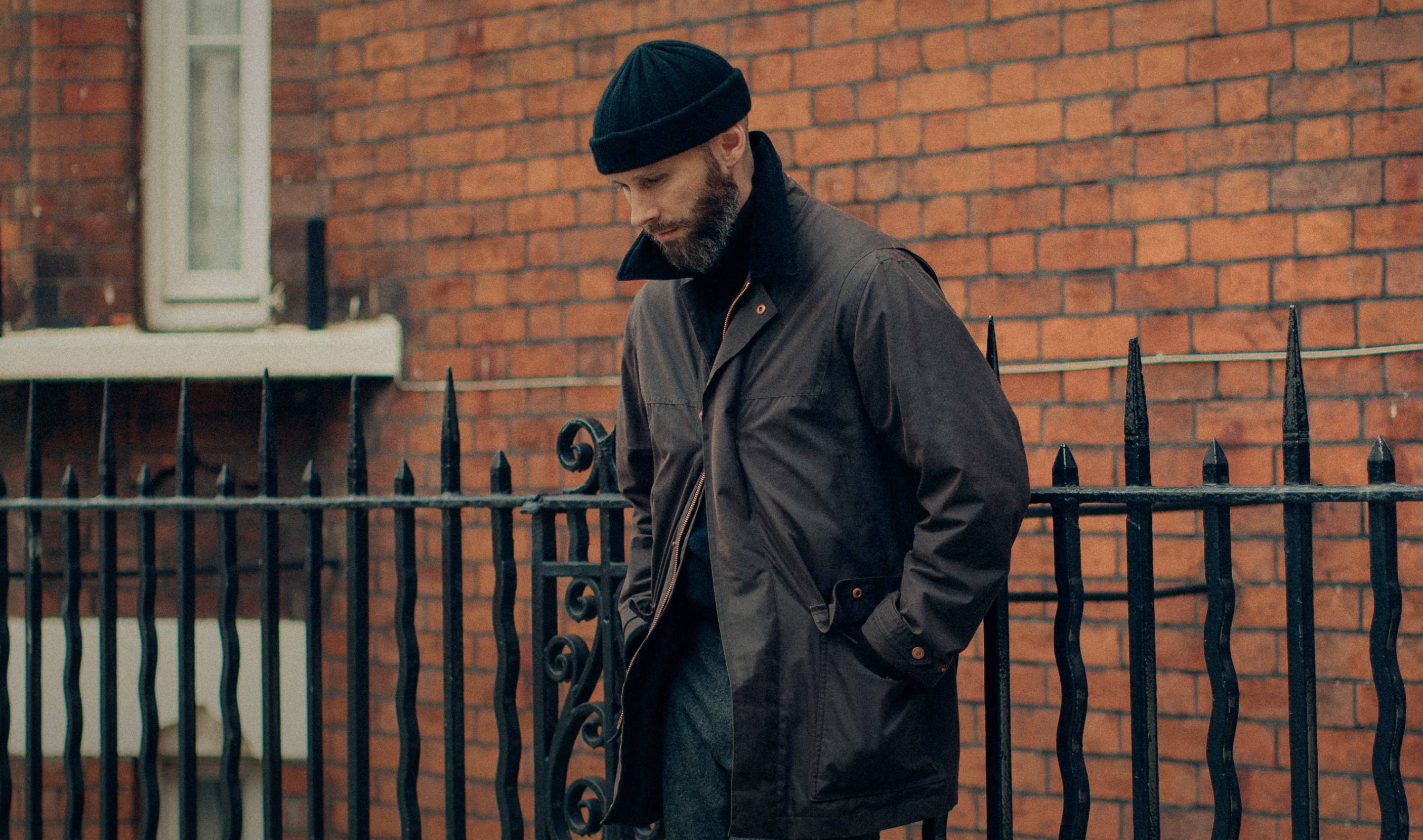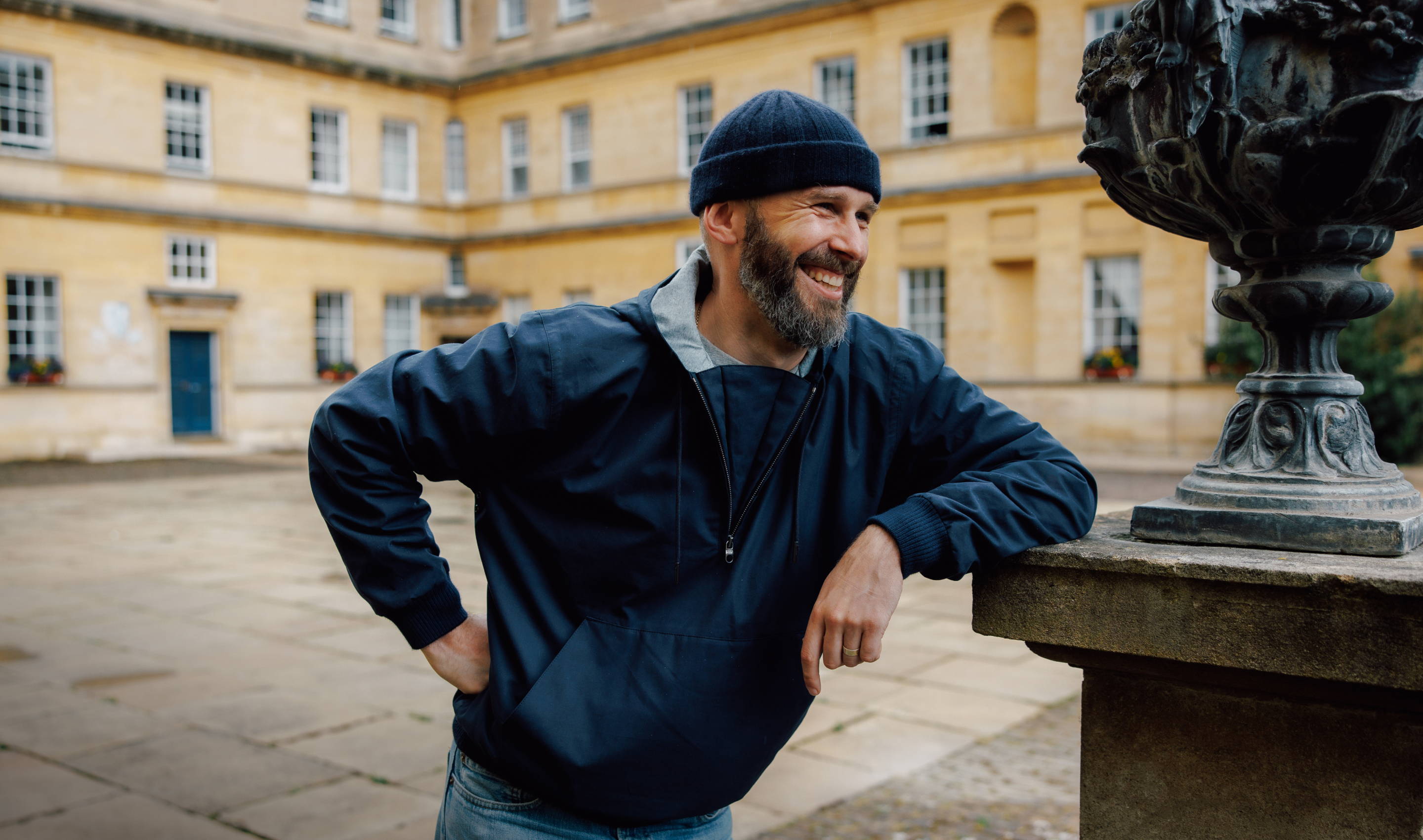Celebrating Manchester’s industrial heritage and the great Mancunian artist who immortalised it.
This Friday marks the 137th anniversary of the birth of one of Britain’s most celebrated artists, L.S. Lowry. Through his work, Lowry shone a light on the industrial cities and working-class communities of Northern England. His iconic landscapes are synonymous with a bygone era, a snapshot of a time when factories and mills dominated the skyline.
This autumn, we celebrate Lowry’s artistic legacy and our shared connection to Manchester’s industrial past with a collection inspired by his vision. Where many saw the cold, wet, and bleak weather of the North as cause for despair, Lowry found in it an opportunity to craft something beautiful. Here at Private White V.C., we share this sentiment.
Born in Manchester in 1887, Laurence Stephen Lowry was immersed in the industrial landscape from a young age. Raised in Salford during the height of the Industrial Revolution, he grew up with the sight of smoke billowing from chimneys and the constant movement of factory workers — scenes that would later become central to his work.
Lowry’s personal experiences further shaped his artistic approach. He held a day job as a rent collector, witnessing firsthand the daily struggles and resilience of the communities he would later immortalise in his paintings. Living what most would consider a solitary life, Lowry never married or had children, a choice that, by his own admission, influenced his art profoundly: “Had I not been lonely, none of my work would have happened. I should not have... seen the way I saw things,”. It was this solitude that gave Lowry a unique perspective, enabling him to capture the hidden beauty amidst what most only saw as the grey and gloomy surroundings.
Though he never pursued art full-time, Lowry attended evening classes at the Salford School of Art, where he developed his distinctive style. His work is defined by his signature ‘matchstick men’— simple yet evocative figures that have come to represent the realities of ordinary people bound up within industrial life. The anonymity of these figures is striking; by omitting individual features, Lowry emphasised their collective strength, reminding us of the resilience and unity that defined the working-class communities of Northern England.
Lowry’s limited colour palette further reinforced the mood he brought to his canvases. Using just five colours throughout his career — flake white, ivory black, vermillion, Prussian blue, and yellow ochre — he created a muted yet powerful depiction of urban life. For Lowry, only by acknowledging the often dark and dreary reality of Manchester's industrial landscape could it be viewed with any sense of dignity. “My ambition,” he once famously said, “was to put the industrial scene on the map because nobody had seriously done it before.” With our AW24 Lowry Collection, we aspire to do something of the same, showcasing the expertise that still thrives here in Manchester’s last working clothing factory.
To commemorate the collection’s launch, we commissioned a unique Lowry-inspired artwork. Created by local Manchester artist Mel Champion, the painting takes inspiration from Lowry’s St Simon’s Church (1928), which stood opposite Cottenham House before being demolished in 1927.
The church is just one of the many buildings surrounding the Private White V.C. factory that no longer remains — a telling sign of the difficulties through which our factory has defiantly battled over the years. The new artwork extends Lowry’s original to include our 173-year-old red-brick factory within the scene, populated with the very same matchstick men in the foreground, only this time they are proudly wearing some of the finest outerwear made in Britain.
Bringing the collection to life also called for a soundscape, bridging the gap between mid-20th century Manchester and today. Composed by sound designer James Hayto, the piece combines references from a series of classical works once played for Lowry’s 77th birthday and the simple four-note guitar riff taken from Status Quo’s ode to Lowry, Pictures of Matchstick Men (1968). Layered beneath these are recordings from our factory — the steady hums and whirls that have echoed along Salford’s River Irwell since 1853.
Our collaboration with the Lowry estate is a connection across two centuries of Northern England’s industrial history. Crafted in one of the few surviving factories that inspired Lowry’s art, this collection is a testament to Manchester’s legacy of quality craftsmanship and a reminder of the message woven throughout Lowry’s work: that sometimes the real beauty of things can only be appreciated by looking deeper beyond the surface.
Go Behind The Scenes
The church is just one of the many buildings surrounding the Private White V.C. factory that no longer remains — a telling sign of the difficulties through which our factory has defiantly battled over the years. The new artwork extends Lowry’s original to include our 173-year-old red-brick factory within the scene, populated with the very same matchstick men in the foreground, only this time they are proudly wearing some of the finest outerwear made in Britain.
Celebrating Manchester’s industrial heritage and the great Mancunian artist who immortalised it.
This Friday marks the 137th anniversary of the birth of one of Britain’s most celebrated artists, L.S. Lowry. Through his work, Lowry shone a light on the industrial cities and working-class communities of Northern England. His iconic landscapes are synonymous with a bygone era, a snapshot
of a time when factories and mills
dominated the skyline.
This Autumn, we celebrate Lowry’s artistic legacy and our shared connection to Manchester’s industrial past with a collection inspired by his vision. Where many saw the cold, wet, and bleak weather of the North as cause for despair, Lowry found in it an opportunity to craft something beautiful. Here at Private White V.C., we share this sentiment.
Born in Manchester in 1887, Laurence Stephen Lowry was immersed in the industrial landscape from a young age. Raised in Salford during the height of the Industrial Revolution, he grew up with the sight of smoke billowing from chimneys and the constant movement of factory workers — scenes that would later become central to his work.
© The Estate of L.S. Lowry. All Rights Reserved, DACS 2023. Photo credit: Rochdale Arts & Heritage Service
Lowry’s personal experiences further shaped his artistic approach. He held a day job as a rent collector, witnessing firsthand the daily struggles and resilience of the communities he would later immortalise in his paintings. Living what most would consider a solitary life, Lowry never married or had children, a choice that, by his own admission, influenced his art profoundly: “Had I not been lonely, none of my work would have happened. I should not have... seen the way I saw things,”. It was this solitude that gave Lowry a unique perspective, enabling him to capture the hidden beauty amidst what most only saw as the grey and gloomy surroundings.
Cottenham House, The Private White V.C. Factory
Though he never pursued art full-time, Lowry attended evening classes at the Salford School of Art, where he developed his distinctive style. His work is defined by his signature ‘matchstick men’— simple yet evocative figures that have come to represent the realities of ordinary people bound up within industrial life. The anonymity of these figures is striking; by omitting individual features, Lowry emphasised their collective strength, reminding us of the resilience and unity that defined the working-class communities of Northern England.
To commemorate the collection’s launch, we commissioned a unique Lowry-inspired artwork. Created by local Manchester artist Mel Champion, the painting takes inspiration from Lowry’s St Simon’s Church (1928), which stood opposite Cottenham House before being demolished in 1927.
The church is just one of the many buildings surrounding the Private White V.C. factory that no longer remains — a telling sign of the difficulties through which our factory has defiantly battled over the years. The new artwork extends Lowry’s original to include our 173-year-old red-brick factory within the scene, populated with the very same matchstick men in the foreground, only this time they are proudly wearing some of the finest outerwear made in Britain.
Bringing the collection to life also called for a soundscape, bridging the gap between mid-20th century Manchester and today. Composed by sound designer James Hayto, the piece combines references from a series of classical works once played for Lowry’s 77th birthday and the simple four-note guitar riff taken from Status Quo’s ode to Lowry, Pictures of Matchstick Men (1968). Layered beneath these are recordings from our factory — the steady hums and whirls that have echoed along Salford’s River Irwellsince 1853.
Our collaboration with the Lowry estate is a connection across two centuries of Northern England’s industrial history. Crafted in one of the few surviving factories that inspired Lowry’s art, this collection is a testament to Manchester’s legacy of quality craftsmanship and a reminder of the message woven throughout Lowry’s work: that sometimes the real beauty of things can only be appreciated by looking deeper beyond the surface.
Go Behind The Scenes
Step behind the scenes and discover how we brought Lowry’s iconic matchstick men to life to showcase our AW24 collection. Captured by renowned photographer Sam Barker, the campaign saw models replicate poses found in Lowry’s bustling landscapes, set against a hand-painted backdrop to evoke the atmosphere of northern England’s 20th century industrial skies.
















Leave a comment
This site is protected by hCaptcha and the hCaptcha Privacy Policy and Terms of Service apply.